Related Research Articles

Ullern is a borough of the city of Oslo, Norway.
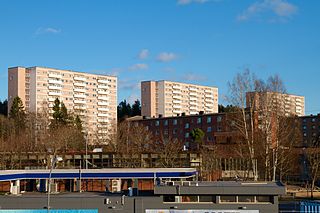
Østensjø is a borough of the city of Oslo, Norway.

Nordre Aker is a borough of the city of Oslo, Norway.

The Oslo Metro is the rapid transit system of Oslo, Norway, operated by Sporveien T-banen on contract from the transit authority Ruter. The network consists of five lines that all run through the city centre, with a total length of 85 kilometres (53 mi), serving 101 stations of which 17 are underground or indoors. In addition to serving 14 out of the 15 boroughs of Oslo, two lines run to Kolsås and Østerås, in the neighboring municipality of Bærum. In 2016, the system had an annual ridership of 118 million.

Stortinget is an underground rapid transit station on the Common Line of the Oslo Metro, Norway. It is located in the heart of the city center, next to the Parliament of Norway Building (Stortinget). The station is served by all of the five lines of the metro. At the street level, the station serves tram routes 11, 12, 13, 17, 18 and 19. Lines 11, 12 and 13 serves Øvre Slottsgate on the Vika Line while Lines 17, 18 and 19 stops at Tinghuset in the Ullevål Hageby Line. Also close to the station, there is a stop named Prof. Aschehougs gate that stops line FB5 to Oslo Airport, Gardermoen. Stortinget is 'kilometer marker zero' for the metro network and is owned by Sporveien T-banen.
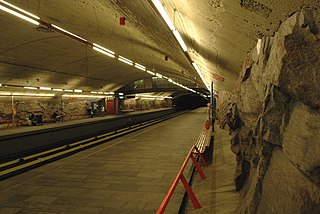
The Grorud Line is a 13.0-kilometer long (8.1 mi) line on the Oslo Metro between Tøyen and Vestli in Oslo, Norway. Built as a mix of underground, at ground level and as an elevated line, it runs through the northern part of Groruddalen, serving such neighborhoods as Grorud, Romsås and Stovner. Line 5 runs along the entire line four times per hour. Line 4 runs between Vestli and Økern before branching off on the Løren Line to get onto the Ring Line. With 40,000 daily riders, the Grorud Line is the busiest branch of the metro.

The Furuset Line is a 5.6-kilometer (3.5 mi) long line on the Oslo Metro between Hellerud and Ellingsrudåsen in Oslo, Norway. Running mostly underground, it passes through the southern part of Groruddalen, serving neighborhoods in the boroughs of Alna and Furuset. The line is served by Line 2 of the metro with four or eight trains per hour. The line is owned by Kollektivtransportproduksjon and operated by Oslo T-banedrift on contract with Ruter using MX3000 trains.

The Østensjø Line is a 9.0-kilometre (5.6 mi) line on the Oslo Metro which runs from Brynseng to Mortensrud. It further shares track with the Lambertseter Line along the 2.5-kilometre (1.6 mi) section from Tøyen to Brynseng. The line runs through the primary residential areas of Bøler, Østensjø and Søndre Nordstrand. The line is served by Line 3 of the metro.

The Lambertseter Line is a 5.9-kilometer (3.7 mi) line on the Oslo Metro which runs from Brynseng to Bergkrystallen. It further shares track with the Østensjø Line along the 2.5-kilometer (1.6 mi) section from Tøyen to Brynseng. The line runs through a primary residential area of Nordstrand, serving neighborhoods such as Manglerud, Ryen and Lambertseter. The line is served by Line 4 of the metro, which runs every fifteen minutes. This is supplemented by Line 1 that is extended to Bergkrystallen between 6:30 and 19 on weekdays, giving a combined frequency of eight trains per hour.
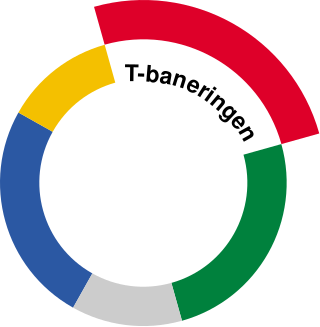
The Ring Line is the newest rapid transit loop line of the Oslo Metro of Oslo, Norway. It connects to the Sognsvann Line in the west and the Grorud Line in the east; along with these two lines and the Common Tunnel, the Ring Line creates a loop serving both the city centre and Nordre Aker borough. The 5.0 kilometres (3.1 mi)-long line has three stations: Nydalen, Storo and Sinsen. Four-fifths of the line runs within two tunnels, with the 1.0-kilometer (0.62 mi) section between Storo and Sinsen, including both stations, being the only at-grade part. The line connects to the Grorud Line north of Carl Berners plass and with the Sognsvann Line north of Ullevål stadion.
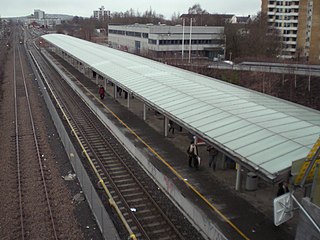
Storo is a rapid transit station on the Ring Line of the Oslo Metro, and a tram station on the Grünerløkka–Torshov Line of the Oslo Tramway. It is located at Storo in the Nordre Aker borough of Oslo, Norway. The tram station opened on 28 November 1902, and the rapid transit station on 20 August 2003. Metro lines 4 and 5 run to the station. The tram station serves lines 11, 12 and 18. The station is within walking distance of Grefsen Station on the Gjøvik Line. The station also functions as a bus hub, being located along Ring 3. Storo is a mixed commercial and residential area, and a shopping center is located just north of the subway station.

Sinsen is a rapid transit station on the Ring Line of the Oslo Metro. It is located at Sinsen in the Sagene borough of Oslo, Norway. Next to the station is the tram station Sinsenkrysset, that has been part of the Sinsen Line of the Oslo Tramway since 1939. The station opened on 20 August 2006, as part of the first section of the Ring Line. The station is served by line 4 and 5 of the metro, as well as several local bus services. Sinsen is a mixed residential and commercial area.

AS Oslo Sporveier is a defunct municipal owned company responsible for public transport in Oslo, Norway. It was created in 1924 to take over the city's two private tram companies. In 1927 its started with bus transport, including from 1940 to 1968 trolleybuses. Since 1966 rapid transit and from 1985 water buses have also been operated by the company. It was split into two separate companies in 2006; Kollektivtransportproduksjon took over the operation while Oslo Public Transport Administration was responsible for buying the services, fare regulation and marketing. The latter merged into Ruter in 2008, when the Oslo Sporveier brand was discontinued.

AS Sporveisbussene is a bus company that operates about 75% of the routes in Oslo, Norway. The company was created in 1997 when the then Oslo Sporveier was reorganised. It is now a subsidiary of Kollektivtransportproduksjon, a municipal company responsible for operating public transport in Oslo. In 2003 the Oslo City Council decided that bus transport in Oslo was to be based on public service obligation contracts, and Sporveisbussene has steadily lost its routes to these contracts. Instead, Sporveisbussene has established a subsidiary, Nexus Trafikk, that can compete in the competitions, and has won many of them. The company also operates the express coaches branded Lavprisekspressen.

The Sagene Line is a former line of the Oslo Tramway in Norway. It ran from Stortorvet in the city center along Akersgata and Ullevålsveien through the neighborhood of St. Hanshaugen. It then continued along Colletts gate, Geitmyrsveien and Kierschouws gate to Sagene. At Sagene Church it had a regulation stop and access to Sagene Depot. The line continued along Bentsebrugata to Torshov, where it intersected with the Grünerløkka–Torshov Line.
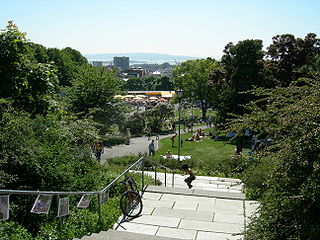
Parks and open spaces are an integral part of the landscape of Oslo, the capital and largest city of Norway. The various parks and open spaces are interconnected by paths so that the city's inhabitants can walk between them.

The Sinsen Line is part of the Oslo Tramway on the east side of the city. Most of the line is served by line 17, although the northernmost tip (Grefsen–Torshov) is served by line 18 which otherwise runs on the Grünerløkka–Torshov Line. Both services use SL95 articulated trams.

The history of the Oslo Tramway and Oslo Metro in Oslo, Norway, starts in 1875, when Kristiania Sporveisselskab (KSS) opened two horsecar lines through the city centre. In 1894, Kristiania Elektriske Sporvei (KES) built the first electric street tramways, which ran west from the city centre. Within six years, all tramways were electric. The city council established Kristiania Kommunale Sporveie (KKS) in 1899, which built three lines before it was sold to KSS six years later. Both KSS and KES were taken over by the municipality in 1924, becoming Oslo Sporveier. The company gradually expanded the city tram network, which reached its peak length in 1939.
The 2008 season of the 3. divisjon, the fourth highest association football league for men in Norway.
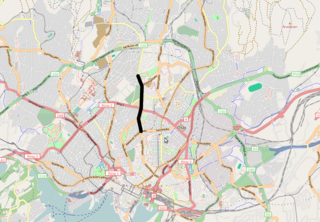
The East End and West End are used as names for the two parts of Oslo, Norway, formed by the economic and socially segregating separation line that has historically passed along the street Uelands gate. The Akerselva river is often seen as a boundary between west and east, but that can be misleading, as there are working-class neighbourhoods on both sides of the river.
References
- ↑ Municipality of Oslo (2020). "Befolkningen etter bydel, kjønn og aldersgrupper 1.1.2020" (in Norwegian). Retrieved 29 April 2020.